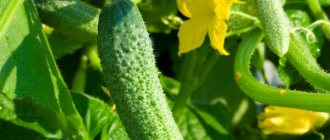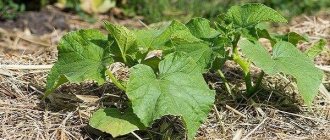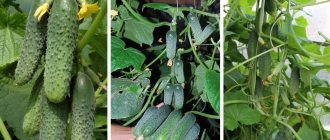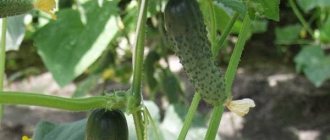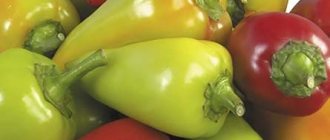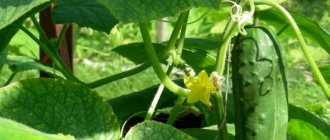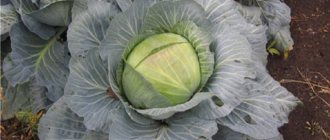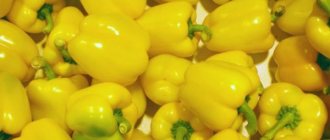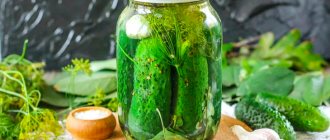Vegetable growing » Cucumbers
0
1742
Article rating
Kira Stoletova
The Tumi cucumber variety is characterized by high yield. On average, up to 20 kg of excellent quality fruits are harvested from 1 m2. They are easy to grow, even a beginner can do them.
Characteristics of the cucumber variety Tumi
Care is traditional and consists of watering, weeding, maintaining temperature conditions, and fertilizing. Correct growing technology is the key to an excellent harvest.
Description
The Tumi cucumber is characterized by the ability to produce a rich early harvest that is stable even in cool weather. The plant has compact internodes, each of which produces 2-3 fruits. The cucumber is easy to care for, resistant to diseases and does not require frequent watering.
Tumi is a parthenocarpic hybrid and is therefore labeled “F1”.
Composition, properties and benefits
Tumi, like all cucumbers, is 97% water; 3% - useful elements.
It contains:
- potassium, which ensures conductivity in the nervous system;
- calcium is the main material for bones;
- phosphorus - part of bone tissue;
- magnesium, sulfur, iron;
- vitamin B1, which plays an important role in healthy metabolism;
- vitamin C, which strengthens the immune system;
- vitamin B2.
Cucumbers have low calorie content, so this vegetable is considered an excellent dietary product for people prone to obesity.
Characteristics
The bush grows on average to 1.5 m and higher. Side shoots grow quickly and actively; old shoots must be removed in a timely manner. Branching is average. The leaves are dark green, slightly wavy in texture.
The average fruit weight is 120-150 g (sometimes 90-100 g). The type of fruit shape is gherkin - elongated, oval. The peel has a rich, dark green color. There are small whitish tubercles that resemble thorns. Pubescence is weak or practically absent.
The pulp of the fruit is tender, crispy, pleasant to the taste, without bitterness and with a pronounced aroma. The hybrid is universal in use: it can be cut into salads, prepared as pickles and pickles.
Productivity is about 9-20 kg of fruits per 1 m².
Characteristics of the variety
According to the description, Tumi cucumbers are intended for growing in spring, summer and autumn rotations in greenhouses. But you can plant it in open ground. Due to resistance to pests and mechanical stress, the fruits will not be affected by diseases.
Brief characteristics of Tumi cucumbers:
- do not deteriorate during transportation and do not lose their presentation;
- tolerate drought well;
- They bear fruit well even in cool weather.
The level of weaving is average. Hybrid f1 has a powerful root system. During drought or frost, the ovary does not shed. It develops actively even at low temperatures. Fruits set frequently and regularly.
Planting density - no more than 3 bushes per 1 m2. This is necessary for the normal formation of the root system of the bushes. This is the optimal distance for plants to actively grow and develop.
It bears fruit 38-42 days after germination, which is why it belongs to the early ripening f1 hybrids. The yield of the crop is long-lasting.
Description of the bushes
The average height of the bush is 1.5 m, but it can grow larger. Side shoots are actively formed. About 2-3 greens grow in one node. One bush consists of 2-3 ovaries. It is necessary to promptly remove all old shoots for the germination of new ones.
Pollination is not necessary for setting, because this is a parthenocarpic hybrid f1. Branching is average. The leaves are dark green with slight waviness.
Description of fruits
The weight of the fruit is 120-150 g. The average length does not exceed 15 cm. Resistant to yellowing and deformation.
According to the description, Tumi fruits have:
- rich dark green color;
- gherkin type of structure;
- coarsely tuberous surface;
- all fruits are the same size;
- smooth, oval, elongated shape;
- white thorns.
There is no bitterness. The pulp inside is tasty and crispy. There is almost no spotting. Pubescence is poorly expressed, practically absent. There are also no white stripes at the end.
Cucumbers are used for fresh consumption. They can be added to cold salads.
Thanks to their crispy skin, they are perfect for preservation, especially for pickling. Their beautiful appearance and low water content make it possible to use Tumi cucumbers for banquet vegetable cuts.
How to grow your own
The place where the cucumbers will grow is dug up in the fall. Already in early May, you can plant seeds in open ground. It is better to plant where tomatoes, potatoes, and cabbage used to grow. For the beds, you need to choose a place in the shade with a temperature of about 27 °C. The soil should be sufficiently warm (about 16 °C). The soil is fed with organic and mineral fertilizer (“Agricola”, “Superphosphate”).
Watering should be done regularly to maintain moisture levels. It is impossible to loosen the soil; weeding is only permissible by hand, since the roots of the cucumber do not go deep underground. You can plant several times from early May to early June in case it gets colder again.
For Tumi cucumber, the seedling method is more suitable. Seedlings are grown in pots or paper cups, then the sprouts are transplanted into a greenhouse. The seeds of this hybrid can be planted at the end of April in order to be transferred to open ground by summer (for autumn and spring rotation, the planting time is shifted).
A special mixture (peat, sawdust and mullein in a ratio of 3:1:0.5), diluted with water, is poured into the planting container. Then add some nitrogen, phosphorus, potassium and lime. There is no need to water the sprouts, since a sufficient level of humidity is already maintained (about 70%).
20-25 days after sowing, the sprouts are taken to the greenhouse, by this time they already have 3-4 leaves. A few days before planting, the seedlings are accustomed to the outside air, and the day before they are fed with mineral fertilizers. Fertilizers are washed off with clean water.
Attention ! Suitable seedling density is 3 plants per 1 m².
Growing and care
Growing order:
- The seeds are sown at the end of April and transferred to the greenhouse at the end of May or beginning of June.
- When 3 full-fledged leaves are formed, the plant is given the first mineral supplement.
- Regularly water with settled warm water (cold water causes gray rot), but you should avoid soil moisture above 90%.
- During the growing season, which lasts 38-40 days for Tumi, you need to feed the cucumbers 2-3 times with mineral fertilizers, alternating with organic ones.
Cucumber can grow in cool weather, but does not tolerate temperature changes well, so the greenhouse is constantly maintained at about 25 °C (when flowering begins - 27 °C). If crust appears on the ground, the soil is loosened to enrich the plant roots with oxygen and improve growth. Mulching is carried out with peat, straw, leaves and sawdust. This helps protect the cucumbers from weeds and climate influences.
Shoots that form above the first 3-4 leaves must be pinched so that the root system develops well. If the bush is growing actively, pinching is not necessary.
Water with warm and settled water only at the root. The stem, leaves and fruits are sprayed with drip irrigation to prevent olive spot and bacteriosis. During periods of drought, you need to water more often - once every 1-2 days. With a lack of moisture, the fruits become bitter.
“Nitrophoska” is suitable as a top dressing. It improves the growth of seedlings and makes the fruits tastier.
Features of cultivation and possible difficulties
Growing this hybrid is easy; even a beginner can handle it. The main thing is to maintain regular watering, mulching, weeding and fertilizing. It is important to maintain a constant level of humidity and heat and check plants for pests.
It is necessary to tie the plants to trellises to give them shape. Gardeners drive strong stakes 1.5-2 m long into the ground, stretch a rope (twine) between them and tie cucumber vines.
Attention! Hybrid seeds will have to be purchased every year.
Susceptibility to diseases and pests
Tumi is resistant to various diseases, especially brown spot (cladosporiosis).
It is important to periodically inspect the plants. Possible infections include cucumber mosaic virus, powdery mildew, and yellow vein virus. As a preventative measure, ventilate the greenhouse once every 2 weeks and wash the doors and windows with a disinfectant solution. Tumi is not resistant to white and gray rot and may suffer from whiteflies.
Diseases and pests
The cucumber variety Tumi is characterized by a high level of resistance to brown spot.
It is important to maintain a humidity of no more than 90% and the correct temperature. Average resistance to cucumber mosaic virus.
Low likelihood of powdery mildew infection. Cucumbers of this variety are not susceptible to infection by the yellowing vein virus.
If the rules of plant care have been violated, the following may appear:
- cladosporiosis;
- white or gray rot;
- whitefly
The main preventive measures are to ventilate the greenhouse once every 2 weeks. Wash windows and doors with a mild solution. If grown in open ground, do not allow the soil to become waterlogged or dry.
Advantages and disadvantages
Advantages:
- high commercial quality and shelf life;
- stable yield;
- high stress resistance;
- resistance to pests and diseases;
- powerful root system;
- long fruiting period;
- excellent taste;
- does not deteriorate in bad weather.
Flaws:
- instability to temperature fluctuations;
- the need to tie up;
- You cannot get the seeds yourself.
Advantages and disadvantages
- Advantages of the variety:
- resistant to cool weather;
- grows both in a greenhouse and in the ground;
- high-yielding;
- has a long fruiting period;
- bears fruit “harmoniously”;
- has good transportability and shelf life;
- resistant to cladosporiosis and powdery mildew.
- Disadvantages of the variety:
- Tumi is a hybrid, so collecting seeds at home is not advisable - their characteristics will not match those of the parent cucumber;
- The fruits are quite large, reaching 15 cm, so it is advisable to collect them regularly to prevent overgrowth.
Did you know? Cucumbers began to be cultivated in India and Mesopotamia 6,000 years ago. According to Indian legend, a cucumber contains exactly 60,000 seeds, which is exactly how many children the Raja is credited with having
“discovery”
of cucumber as a vegetable crop.
Reviews
When describing cucumber varieties, gardeners pay attention to resistance to weather conditions and the taste of the fruit. Toomey scores well on these measures.
Larisa, Volkhov: “We have a cool and not very sunny climate. The weather has no effect on the appearance of fruits and a huge number of shoots, the old ones of which must be removed. You don’t need insects for pollination, it’s convenient.”
Igor, Mozhaisk: “The Tumi cucumber grows equally well in a greenhouse and in open ground. The fruits are large and beautiful, as in the photo on the package. Good taste - the flesh is juicy, dense and without a bitter aftertaste.”
Growing and care
The basic rule in hybrid agricultural technology is regularity and timeliness. The bushes are pruned; to do this, pinch the tops of the side branches behind 3-4 leaves. Due to the average branching rate, the main shoot is pinched from above.
During the season, cucumbers need 3-4 feedings. Organics and minerals are added alternately. Alternate the root method and foliar feeding. Particular attention is paid to ensure that the cucumber receives the following components:
| Microelements | Action |
| Nitrogen | Increases germination and vegetation |
| Potassium | Affects taste and product indicators |
| Phosphorus | Important for density, elasticity, juiciness of fiber |
Preparations for foliar irrigation:
- Plantafol;
- Dobrivo;
- Megafol;
- Terraflex;
- urea.
How to properly care for Tumi?
- Sowing seeds for seedlings is carried out at the end of April. Transplantation into beds is done in May or early June, when the cucumber has 4 leaves.
- The first mineral fertilizing is carried out after the first 3 true leaves appear.
- Cucumbers require regular watering with warm water. But you can’t over-moisten the soil.
- During the entire growing season, it is necessary to carry out 3 mineral fertilizing. They must be alternated with the addition of organic matter.
- Foliar fertilizing is encouraged. The best means for this: urea, Plantafol, Terraflex, Megafol.
Agricultural technology
Tumi shows the best results when grown in seedlings. For cultivation in summer rotation, seeds are sown in April. After about 22 days, the cucumber seedlings are ready to be transplanted to a permanent place in the greenhouse; by this time they should have at least 3 true leaves. To use the variety in spring or autumn rotation, the seed sowing date is shifted. The culture has a powerful root system, but prefers well-drained and fertile soil. Grows well on treated and fertilized loams. The recommended planting density is about 3 plants per 1 square meter. The plant must be tied to a trellis and formed into one stem, removing growing side shoots. In the greenhouse, you need to control the humidity level and try to maintain the temperature within 25 °C. Otherwise, caring for the variety is no different from the generally accepted one. If you cultivate a vegetable in the southern regions, then caring for it is simplified due to the ability to abandon the garter in favor of the usual spread method. Plant the cucumber in an area with diffuse partial shade so that the foliage does not burn.
Read also: Do-it-yourself pump from a pipe
The Tumi hybrid is intended for cultivation in greenhouses, has an early ripening period and has high parthenocarpy, which means it is suitable for extended rotation. From one plant you can harvest an excellent harvest of pickles and gherkins, which have high pickling qualities. The combination of characteristics such as disease resistance and rapid recovery after an unfavorable period increases the demand for the variety among farmers growing vegetables for sale. Our hero is still very young, but during the time they got to know him, gardeners did not identify any significant shortcomings, except for the need to tie up and shape the plant. In addition, seed material will have to be purchased annually, since it will not be possible to collect cucumber seeds on your own.
What could be better than a crispy fresh cucumber grown with love and care? If you love growing cucumbers, then with Tumi, you can enjoy juicy greens all summer long. And also roll up pickled gherkins and delicious pickles for the winter.
Harvest and storage
Cucumber fruits grow quickly. Harvesting must be done regularly, starting from the moment the first batch ripens. Cucumber plants are able to control the formation of ovaries, so unpicked cucumbers delay further formation of ovaries. Cucumbers are harvested in the morning, daily or every other day. The fruit is supported by hand and the tail is cut off with pruning shears, leaving about 1.5 cm.
Collected cucumbers are stored for 7–10 days without loss of quality in a cool, dry room. The air temperature in it should not exceed +10°C (in the basement, cellar). The box for cucumbers should have holes for ventilation of vegetables. Greens can be stored in a plastic bag in the refrigerator for about 14 days.
Learn how to preserve crispy cucumbers.
The bag will not allow the cucumbers to lose their elasticity and wither. Caring for cucumbers is not too difficult. If the site for cultivation is chosen correctly and basic agrotechnical measures are followed, then you can reap a good harvest of tasty vegetables.
